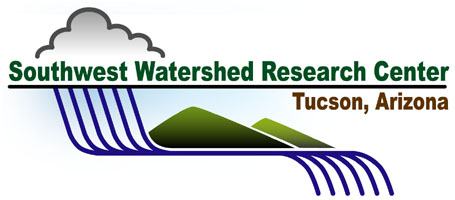| SWRC Bulletin (Winter 2008) |

|
  |  | The SWRC BulletinSound Science for Water Decisions Winter 2008 |
Latest Science Results (not yet published) (click on title for more information) Assessing hillslope heterogeneity for rainfall-runoff modeling: KINEROS 2 case study Investigating uncertainty in distributed flash-flood forecasting for semi-arid regions Quantifying Riparian Evapotranspiration Separation and Measurement of Soil Carbon Dioxide Organic and Inorganic Fluxes Fifty Years of research and data collection, USDA-ARS Walnut Gulch Experimental Watershed Evaluating Hydrological Response To Forecasted Land-Use Change Post wildfire runoff and erosion from oak woodlands in southeastern Arizona, USA Remote Sensing of Rangeland Health in Localizing the Rangeland Health Method for Loamy Creating Decision Support Systems for Arid Environments
| Highlight from Recently Published Research
(click on title to download a reprint)
Wagener, T., Gupta, H., Yatheendradas, S., Goodrich, D.C., Unkrich, C.L., Schaffner, M. 2007. Understanding sources of uncertainity in flash-flood forecasting for semi-arid regions.International Association of Hydrologic Sciences. 313:204-212. (1654 KB PDF)
Malone, R.W., Huth, N., Carberry, P.S., Ma, L., Kaspar, T.C., Karlen, D.L., Meade, T., Kanwar, R.S., Heilman, P. 2007. Evaluating and predicting agricultural management effects under tile drainage using modified APSIM.Geoderma. 140:310-322. (1025 KB PDF)
Malone, R.W., Ma, L., Karlen, D.L., Meade, T., Meek, D., Heilman, P., Kanwar, R.S., Hatfield, J.L. 2007. Empirical analysis and prediction of nitrate loading and crop yield for corn-soybean rotations.Geoderma. 140(3): 223-234. (779 KB PDF)
Malone, R.W., Ma, L., Heilman, P., Karlen, D.L., Kanwar, R.S., Harfield, J. 2007. Simulated N Management Effects on Corn Yield and Tile-Drainage Nitrate Loss.Geoderma. 140:272-283 (738 KB PDF)
Santanello, Jr, J.A., Peters-Lidard, C.D., Garcia, M.E., Mocko, D.M., Tischler, M.A., Moran, M.S., Thoma, D.P. 2007. Using remotely-sensed estimates of soil moisture to infer soil texture and hydraulic properties across a semi-arid watershed.Remote Sensing of Environment. 110:79-97. doi:10.1016/j.rse.2007.02.007 (1693 KB PDF)
Wei, H., Nearing, M. A., Stone, J.J. 2007. A new sensitivity analysis framework for model evaluation and improvement using a case study of the Rangeland Hydrology and Erosion Model.Trans. Am. Soc. Agric. Bio. Eng. 50(3): 945-953. (1235 KB PDF)
Bulygina, N.S., Nearing, M.A., Stone, J.J., Nichols, M.H. 2007. DWEPP: A dynamic soil erosion model based on WEPP source terms.Earth Surface Proceses and Landforms. 32:998-1012. (520 KB PDF)
Miller, S.N., Guertin, D.P., Goodrich, D.C. 2007. Hydrologic Modeling Uncertainty Resulting from Land Cover Misclassification.Journal of the American Water Resources Association. 43(4):1065-1075. (1015 KB PDF)
Emmerich, W.E. 2007. Ecosystem water use efficiency in a semiarid shrubland and grassland community.Rangeland Ecology and Management. 60:464-470. (205 KB PDF)
Yepez, E.A., Scott, R.L., Cable, W.L., Williams, D.G. 2007. Intraseasonal variation in water and carbon dioxide flux components in a semiarid riparian woodland.Ecosystems. 10:1100-1115. (472 KB PDF)
Scott, R.L., Williams, D.G., Huxman, T.E., Hultine, K.R., Goodrich, D.C. 2008. Quantifying Riparian Evapotranspiration.Southwest Hydrology. 7(1): 26-27 (716 KB PDF)
Jackson, R.J., Moran, M.S., O'Neill, P.E. 2008. Introduction to Soil Moisture Experiments 2004 (SMEX04) Special Issue.Remote Sensing of Environment 112:301-303. (102 KB PDF)
Rahman, M.M., Moran, M.S., Thoma, D.P., Bryant, R., Holifield Collins, C.D., Jackson, T., Orr, B.J., Tischler, M. 2008. Mapping surface roughness and soil moisture using multi-angle radar imagery without ancillary data.Rem. Sens. Env. 112:391-402. (1958 KB PDF)
Thoma, D., Moran, M.S., Bryant, R., Rahman, M., Holifield Collins, C., Keefer, T.O., Noriega, R., Osman, I., Skirvin, S., Tischler, M., Bosch, D., Starks, P.J., Peters-Lidard, C. 2008. Appropriate scale of soil moisture retrieval from high-resolution radar imagery for bare and minimally vegetated soils.Remote Sensing of Environment. 112:403-414. (1248 KB PDF)
Cosh, M.H, Jackson, T.J., Moran, M.S., Bindlish, R. 2008. Temporal persistence and stability of surface soil moisture in a semi-arid watershed.Rem. Sens. Env. 112:304-313 (722 KB PDF) Our full publication list is available at
Future Science Events: Click here for information about upcoming conferences, workshops and meetings, including the 3rd ICRW, 5th RISE and annual state-wide Space Grant Symposium.
Rainfall Report: WGEW and SRER data can be downloaded from the web site at http://www.tucson.ars.ag.gov/dap
Geographic locations of the three precipitation records can be found at /ARSUserFiles/20221000/images/sw_az3.jpg Awards: SWRC Scientists contributed to science teams that won three prestigious awards in 2007, including the Nobel Peace Prize. Click here for more information. Staff News: Click here for an introduction to our new staff members Mike Honea and Erik Hamerlynck and other news about staff activities. SWRC Bulletin: Contact the SWRC Research Leader, Dr. Mark Nearing at 670-6380 x152 or mark.nearing@ars.usda.gov. Mailing address is USDA ARS SWRC, SWRC To develop knowledge and technology to conserve water and soil in semi-arid lands. |




